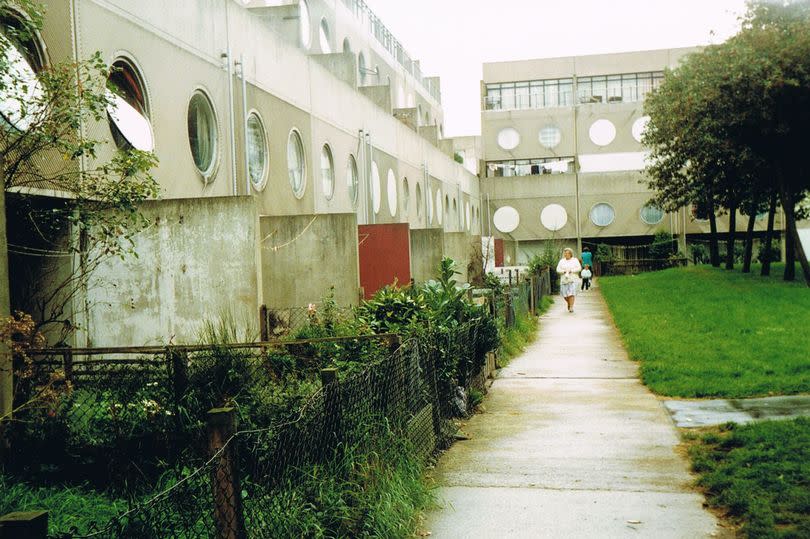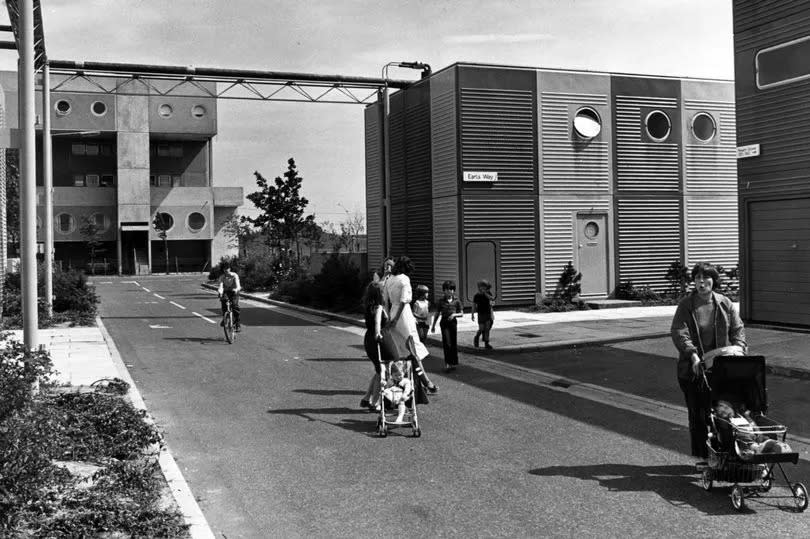The rise and fall of Southgate estate: Cheshire's futuristic social housing experiment

The Southgate estate, with its 'washing machine' porthole windows, vibrant plastic walls and sky-high walkways, was a sight to behold for families relocated from the terraced streets of inner-city Manchester. It was a radical solution to the slum clearances in Manchester and Liverpool, representing one of the last grand experiments in 20th century social housing.
However, it only stood for 15 years before being demolished, reports the Manchester Evening News.
In the mid-20th century, the slum clearances in Manchester and Liverpool led to the development of 'new towns' and 'overspill estates'. Many Mancunians found themselves relocated to tower blocks and council estates such as Wythenshawe, Langley in Middleton or Darn Hill in Heywood, while others ended up in Southgate, located in the Cheshire new town of Runcorn.
Esteemed modernist architect Sir James Stirling designed the Southgate estate, drawing inspiration from the grand Georgian terraces of Bath and Edinburgh. The estate, which housed 6,000 people in 1,500 homes, was first commissioned in 1967 but only completed a decade later
.
The estate, known for its flat-roofed terraced housing and deck-access apartment blocks, was interconnected by 'streets in the sky' walkways. These walkways allowed residents to bypass traffic and provided easy access to Runcorn Shopping City.
The apartments were constructed from concrete panelling with vibrant plastic cladding in bold blue, yellow and orange, earning the estate the nickname 'Legoland'.
Mr Stirling, the architect behind the original plans for the Lowry arts centre at Salford Quays, revealed that the portholes, affectionately referred to as 'washing machines' by residents, drew inspiration from Liverpool's maritime heritage.

However, the estate quickly began to decline, with the deck-access apartments making surveillance challenging, leading to an increase in crime. Residents, who had been relocated from slums to new homes, soon began voicing complaints about anti-social behaviour, noise, and a host of other issues.
Furthermore, the decision to install an oil-fired central heating system resulted in tenants being unable to afford to heat their homes following the oil crisis of the early 1970s. Residents also expressed dissatisfaction over the inability to personalise the exterior of their homes, the lack of private garden space for many, and the radical appearance of the development, which was vastly different from the traditional housing they had come from and available elsewhere in the region.
The estate, plagued by numerous issues, saw families leaving in droves, leading to vacant properties and a reputation as a 'dumping ground for undesirables'. By the mid-1980s, Southgate was in a state of disrepair.
A jaw-dropping £20m bill was estimated for its repair and maintenance over the next 15 years. This led the Warrington and Runcorn Development Corporation to decide in 1989 to completely demolish it.
Demolition work on Southgate began in 1990 and, by 1994, the entire estate had been wiped off the map, later replaced by a more traditional brick and tile suburban housing development. Despite its short lifespan, the demolition of Southgate continues to ignite conversation.
An article from the Manchester-based Modernist magazine in 2011 mourned the loss of Southgate, stating it 'was a loss not just for Runcorn but for the entire second generation of new towns and to British architecture as a whole'.
The publication emphasised that the estate was 'largely the victim of an original budget that was far too low to create sufficient quality for such a high-density scheme'. It further suggested that had Southgate survived, it would have become 'one of the major monuments to this significant period and a key site of architectural pilgrimage in northwest England'.
In a candid 2010 interview with Architect magazine, Michael Wilford, who collaborated with Stirling on the project, openly acknowledged their role, admitting they had embraced the task of working within a problematic low-budget housing setting.
Still, he slammed the demolition as a 'national scandal', stating: "We only knew about it once the decision had been taken."
Highlighting the economic burden on citizens, he said: "As taxpayers, we are probably still paying for it."
Wilford made a case that "The cost of even radical alterations would have been nothing compared to demolition and replacement."
NEWSLETTER: Sign up for CheshireLive email direct to your inbox here

 Yahoo News
Yahoo News 
